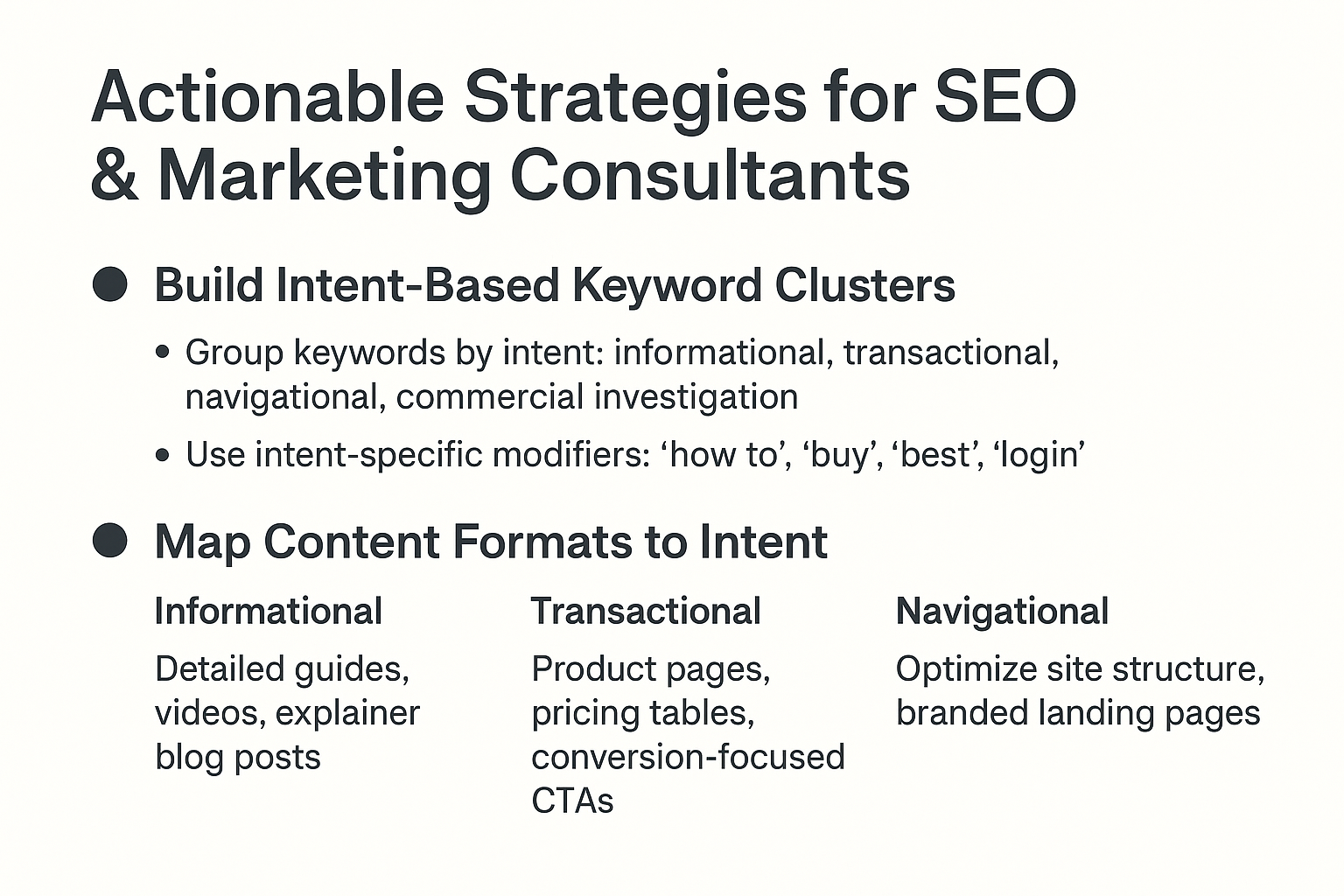Which retrieval features influence intent matching?

Summary (TL;DR)
Retrieval features that influence intent matching in search engines include query interpretation, contextual analysis, keyword specificity, SERP content signals, behavioral data, and personalization. Optimizing for these features—via clear intent-driven keywords, structured content, and user engagement—dramatically boosts SEO performance, engagement rates, and conversion metrics[[1]](https://rush-analytics.com/learn-seo/search-intent-seo-guide)[[2]](https://www.imarkinfotech.com/mastering-seo-why-search-intent-trumps-keyword-optimization/)[[3]](https://www.alliai.com/seo-glossary/search-intent)[[4]](https://thriveagency.com/news/the-importance-of-user-intent-in-seo-how-to-attract-the-right-audience/). For marketing and SEO consultants, aligning on-page strategy with these factors delivers measurable ROI and improved organic visibility.
---
Introduction
Intent matching is central to modern SEO strategy. Search engines use advanced retrieval features to determine a user’s intent—be it informational, navigational, commercial, or transactional—and deliver content that best fulfills that intent[[1]](https://rush-analytics.com/learn-seo/search-intent-seo-guide)[[3]](https://www.alliai.com/seo-glossary/search-intent). For marketing and SEO professionals, understanding which retrieval features affect intent matching allows for data-driven content and technical optimization that meets both user needs and business goals[[2]](https://www.imarkinfotech.com/mastering-seo-why-search-intent-trumps-keyword-optimization/)[[4]](https://thriveagency.com/news/the-importance-of-user-intent-in-seo-how-to-attract-the-right-audience/). This blog dissects the critical retrieval features shaping intent matching, provides actionable insights, and demonstrates how to capitalize on them for your clients.
---

What Retrieval Features Influence Intent Matching?
1. Query Interpretation & Contextual Understanding
Key Feature: Search engines interpret user queries using syntax, semantics, and natural language processing (NLP) models to deduce intent[[3]](https://www.alliai.com/seo-glossary/search-intent)[[8]](https://marketbrew.ai/a/information-retrieval-seo)[[9]](https://cognitiveseo.com/blog/22986/search-intent/).
- Queries containing "how," "what," or "guide" signal informational intent.
- Intent is further refined through semantics (e.g., the word "best" in "best laptops 2025" signals commercial investigation)[[3]](https://www.alliai.com/seo-glossary/search-intent).
- NLP models analyze entities, relationships, and topic inclusion, dramatically improving the intent classification in complex or ambiguous queries[[3]](https://www.alliai.com/seo-glossary/search-intent)[[8]](https://marketbrew.ai/a/information-retrieval-seo).
2. Keyword Specificity & SERP Content Types
| Keyword Example | Likely Intent | Feature Influencing Retrieval | SERP Content Type |
|---------------------------------|----------------------|-------------------------------------|-------------------------------|
| “How to bake sourdough bread” | Informational | Question Phrase Recognition | Blog Posts, Guides, Videos |
| “Buy iPhone 16 online” | Transactional | Transactional Phrase Identification | Product Listings, Shopping Ads|
| “Best SEO tools 2025” | Commercial | Comparison Phrase Recognition | Product Comparisons, Reviews |
| “SEMrush login” | Navigational | Branded/Navigational Trigger | Login Pages, Homepages |
Optimizing for keywords and content types that align with intent increases chances of higher ranking and better matches user needs[[1]](https://rush-analytics.com/learn-seo/search-intent-seo-guide)[[5]](https://www.theadfirm.net/content-seo-matching-keywords-with-intent/)[[3]](https://www.alliai.com/seo-glossary/search-intent).
3. SERP Analysis & Content Signals
Feature: Search engines analyze SERP performance data—like click-through rates (CTR), bounce rates, and dwell time—to refine understanding of what best satisfies intent[[2]](https://www.imarkinfotech.com/mastering-seo-why-search-intent-trumps-keyword-optimization/)[[3]](https://www.alliai.com/seo-glossary/search-intent).
- Featured snippets often indicate Google sees a dominant informational intent.
- Shopping carousels signal high transactional or commercial investigation intent[[3]](https://www.alliai.com/seo-glossary/search-intent)[[4]](https://thriveagency.com/news/the-importance-of-user-intent-in-seo-how-to-attract-the-right-audience/).
- Monitor top-performing SERP content to reverse-engineer what signals search engines are prioritizing for each query type[[4]](https://thriveagency.com/news/the-importance-of-user-intent-in-seo-how-to-attract-the-right-audience/).
4. Personalization & User Behavior Modeling
Feature: Retrieval models leverage users' search and interaction histories to personalize results[[3]](https://www.alliai.com/seo-glossary/search-intent).
- Someone with a history of shopping queries may see more transactional content for similar keywords.
- Geographic location & device: Local intent queries (e.g., “coffee shop near me”) trigger map features and local pack listings.
5. Structural Content Features
Elements That Influence Retrieval:
- Title tags and meta descriptions: Both should reflect target intent and use keywords that match the identified user goal[[3]](https://www.alliai.com/seo-glossary/search-intent)[[4]](https://thriveagency.com/news/the-importance-of-user-intent-in-seo-how-to-attract-the-right-audience/).
- Header tags (H1, H2, H3, etc.): Signal relevance by including intent-aligned phrases[[3]](https://www.alliai.com/seo-glossary/search-intent).
- Content formatting: Bulleted lists, answer boxes, and multimedia enhance the likelihood of being retrieved for featured snippets or “People Also Ask” results[[4]](https://thriveagency.com/news/the-importance-of-user-intent-in-seo-how-to-attract-the-right-audience/).
6. Internal Data & On-Site Search
- Internal site searches and behavioral analytics can reveal gaps in intent matching, allowing for continuous content refinement[[4]](https://thriveagency.com/news/the-importance-of-user-intent-in-seo-how-to-attract-the-right-audience/).
- Tracking pages per session and user pathways identifies mismatches between content provided and user expectations[[2]](https://www.imarkinfotech.com/mastering-seo-why-search-intent-trumps-keyword-optimization/).
---

Actionable Strategies for SEO & Marketing Consultants
1. Build Intent-Based Keyword Clusters
- Group keywords by intent: informational, transactional, navigational, commercial investigation[[1]](https://rush-analytics.com/learn-seo/search-intent-seo-guide)[[4]](https://thriveagency.com/news/the-importance-of-user-intent-in-seo-how-to-attract-the-right-audience/).
- Use intent-specific modifiers (e.g., "how to," "buy," "best," "login")[[1]](https://rush-analytics.com/learn-seo/search-intent-seo-guide)[[3]](https://www.alliai.com/seo-glossary/search-intent).
2. Map Content Formats to Intent
- For informational: Create detailed guides, videos, and explainer blog posts.
- For transactional: Develop product pages, pricing tables, and conversion-focused CTAs.
- For navigational: Optimize site structure and branded landing pages.
- For commercial: Build robust reviews, comparison tables, and FAQs.
3. Analyze and Adapt Using Behavioral Data
- Monitor CTR, bounce rate, dwell time, and session metrics.
- Continuously refine content and on-page elements according to user interactions and SERP changes[[2]](https://www.imarkinfotech.com/mastering-seo-why-search-intent-trumps-keyword-optimization/)[[3]](https://www.alliai.com/seo-glossary/search-intent).
4. Audit SERPs Regularly
- Track shifts in dominant content types for core keywords, adjusting content strategy when intent patterns evolve[[1]](https://rush-analytics.com/learn-seo/search-intent-seo-guide)[[4]](https://thriveagency.com/news/the-importance-of-user-intent-in-seo-how-to-attract-the-right-audience/).
- Use Google’s “People Also Ask,” autosuggest, internal analytics, and related searches as intent research tools[[4]](https://thriveagency.com/news/the-importance-of-user-intent-in-seo-how-to-attract-the-right-audience/).
5. Structure Content for Easy Parsing
- Clear H1s and meta tags with intent-focused language.
- Use schema markup for product, FAQ, and article content to influence enhanced SERP features[[3]](https://www.alliai.com/seo-glossary/search-intent)[[4]](https://thriveagency.com/news/the-importance-of-user-intent-in-seo-how-to-attract-the-right-audience/).
---
Conclusion/Key Takeaways
Successful intent matching is rooted in understanding and optimizing for retrieval features that bridge user needs and search algorithms. By aligning query interpretation, keyword selection, SERP analysis, and on-site optimization with intent categories, marketing and SEO consultants can drive higher organic visibility, user engagement, and conversions. Regular SERP auditing, intent-based keyword targeting, and content restructuring are essential to delivering ROI and sustaining competitive advantage.
---
FAQs
Q1: What are the most influential retrieval features for intent matching?
A: Key features are NLP-based query analysis, keyword specificity, behavioral metrics, personalized search history, and SERP content signals[[1]](https://rush-analytics.com/learn-seo/search-intent-seo-guide)[[3]](https://www.alliai.com/seo-glossary/search-intent).
Q2: How can I tell the intent behind a keyword?
A: Analyze modifiers in the query, review top SERP content, and use intent-focused keyword tools[[1]](https://rush-analytics.com/learn-seo/search-intent-seo-guide)[[2]](https://www.imarkinfotech.com/mastering-seo-why-search-intent-trumps-keyword-optimization/)[[4]](https://thriveagency.com/news/the-importance-of-user-intent-in-seo-how-to-attract-the-right-audience/).
Q3: Does improving intent matching increase ROI?
A: Yes. Sites optimizing for intent see 25–50% more organic traffic and 10–30% lower bounce rates in 3–6 months[[2]](https://www.imarkinfotech.com/mastering-seo-why-search-intent-trumps-keyword-optimization/).
Q4: What tools help identify intent retrieval features?
A: Use Ahrefs, SEMrush, Google Search Console, and analytics platforms for keyword clustering, SERP tracking, and behavioral insights[[1]](https://rush-analytics.com/learn-seo/search-intent-seo-guide)[[4]](https://thriveagency.com/news/the-importance-of-user-intent-in-seo-how-to-attract-the-right-audience/).
---
Citations
- Types of Search Intent in SEO: a Quick Guide - Rush Analytics
- Mastering SEO: Why Search Intent Trumps Keyword Optimization
- Search Intent: What it is and Why it matters in SEO - Alli AI
- The Importance of User Intent in SEO | Thrive Agency
- Content SEO: Matching Keywords with Intent - The Ad Firm
- What is search intent? - STAT Search Analytics
- Applying Information Retrieval To SEO: A Complete Guide
- How To Identify & Best Optimize for User Search Intent. The Step by ...
- Search Intent and How It Aligns SEO and Google Ads Campaigns